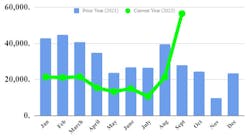Class 8 orders soar in September to record high. Can OEMs deliver?
ACT Research and FTR Transportation Intelligence on Oct. 5 both reported record Class 8 orders for September, a possible sign of recovering new commercial vehicle production that has been restrained the last two years by a clogged supply chain and chronic shortages of many critical components such as semiconductors but also electrical wiring and harnesses, axles, tires, mirrors, and plastic components.
According to a release from ACT, September new Class 8 orders were 53,700 units—the most for any month ever—while Classes 5-7 net orders were 26,600 units. Both numbers are preliminary pending final data to be published by ACT in mid-October. Meanwhile, FTR disclosed in its own Oct. 5 release that preliminary North American Class 8 orders were 56,500 units, also the most for any month on record.
See also: What can fleets expect in 2023?
“September Class 8 orders were sensational no matter how you slice the data,” said Eric Crawford, ACT’s VP and senior analyst, pointing to total Class 8 orders the past year that totaled 249,800. Orders in September were up 161% over August and plus-94% year-over-year, “equivalent to more than 730,000 units on a seasonally adjusted annualized basis,” he said in a release from ACT.
Meanwhile, FTR said its data had September order activity up even higher—169% over the previous month and plus-102% year-over-year, with Class 8 orders totaling 254,000 units for the last 12 months.
Medium-duty orders also were impressive, ACT’s Crawford added. “MD demand was strong,” he said, with September Classes 5-7 orders increasing 39% sequentially (plus 7% year-over-year) to 26,600. ACT’s numbers for all classes come from the research firm’s constantly updated State of the Industry: Classes 5-8 Vehicles report on current production, sales, and the general state of the on-road heavy- and medium-duty commercial vehicle markets in North America.
FTR’s commercial vehicle analyst, Charles Roth, sounded a note of caution about celebrating a premature end to slower new-truck production and an easing of backlogs, though he conceded that September turned out the be an encouraging month.
“With order boards officially open for 2023 build spots, Q4 monthly order levels will likely be dependent on how far into 2023 manufacturers are comfortable accepting orders amidst an unforgiving supply chain environment that is now expected to persist well into 2023,” Roth remarked in FTR's release.
See also: The struggle continues for truck, trailer OEMs to manage fleet demand
In a later interview with FleetOwner, he said the upcoming fall months will be telling in terms of whether a trend is developing that would cause industry stakeholders to be encouraged about new-truck production.
"We may see a dramatic decrease in orders next month," Roth added. "I don’t think the build rates will drastically improve. There’s too much of a lag. It would take three or four months of sustained order activity to see" new-vehicle production improvement. “Next month will be extremely telling about whether OEMs will be able to deliver. OEMs are no longer gambling on the supply chain. They have most of their dealers on allocations.”
ACT’s president and senior analyst, Kenny Vieth, also said the September numbers indicate there should be some optimism that new-truck production is recovering—“We see gradual improvement in the supply chain situation”—but he cautioned as well against reading too much into the month's order surge other than as a rebound from middling orders in the April through July 2022 period, when they averaged just 14,100 units per month.
But "fleets have an awful lot of dry powder and a lot of old trucks at this point," Vieth said.
Pent-up demand adds pressure for OEMs
September order activity is further testimony that there remains a tremendous level of pent-up demand, FTR’s release stressed. While September’s spike is a positive sign for the industry, build rates continue to be impacted by component shortages as suppliers continue to face supply chain bottlenecks and labor shortages, the research firm warned.
“Demand continues to put pressure on manufacturers as many dealerships have now indicated that OEMs are now allocating production capacity for 2023 build slots,” Roth noted in the FTR release. “This is in large part an effort to improve on-time delivery performance while also reducing the impact a potential component shortage may have on production plans.”
See also: Topsy-turvy times for used trucks
“Fleet confidence remains solid entering 2023,” he added, “as many large national fleets are getting their truck orders in as early as possible for next year's deliveries. Due to the limited availability of new equipment, fleets have not been able to phase out aged equipment over the past two years. As a result, we anticipate replacement demand to stay elevated throughout 2023.”
Because of commercial carriers being generally restrained from acquiring new trucks, the used-truck market took off to unseen heights last year and this year. The market for used commercial vehicles—even older models with higher mileage—has been the beneficiary of the new truck market’s sluggishness.
At their apparent peak in March through May this year, a 3-year-old used Class 8 with typical mileage (about 400,000 miles) cost $165,000 to $175,000—or about 80% more than normal, according to Chris Visser, senior analyst and product manager for J.D. Power. ACT and FTR’s data also showed this trend, FleetOwner reported last month.
Prices have eased since this spring, Visser said, but they are still about 65% higher now for the same 3-year-old commercial vehicle, meaning that vehicle will set you back about $135,000 when they would normally be in the $80,000 to $90,000 range. The price explosion in used trucks cut across the retail, wholesale, and auction segments of the market, said sources, including auctioneer Richie Bros.—unusual since the different parts of the used market serve different parts of the industry.
Vieth agreed Oct. 5 that carriers might fill the market with used equipment if the valves finally open in 2023 on new-truck availability, but a lot must happen—easing of component shortages and other random economic factors—before the push-pull dynamic of new trucks vs. used trucks becomes known in the new year.
About the Author
Scott Achelpohl
Managing Editor
Scott Achelpohl is a former FleetOwner managing editor who wrote for the publication from 2021 to 2023. Since 2023, he has served as managing editor of Endeavor Business Media's Smart Industry, a FleetOwner affiliate.


